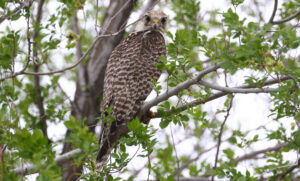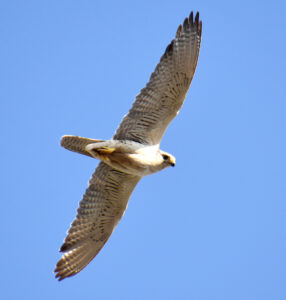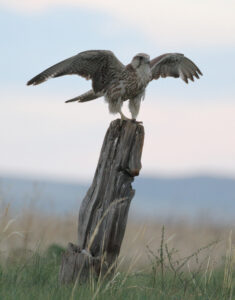Third International Scientific and Practical Conference “Eagles of the Palearctic: Study and Conservation”
Raptors Conservation. Suppl. 2. Proceedings of Conferences
Current Problems of Saker Falcon Conservation in The Republic of Kazakhstan
Ongarbaev N.Kh. (Biodiversity Research and Conservation Center Community Trust, Astana, Kazakhstan)
Contact:
Ongarbayev Nurlan Email: nongarbayev@brcc.kz
Recommended citation: Ongarbaev N.Kh. Current Problems of Saker Falcon Conservation in The Republic of Kazakhstan. – Raptors Conservation. 2023. S2: 469–474. DOI: 10.19074/1814-8654- 2023-2-469-474 URL: http://rrrcn.ru/en/archives/35234
Saker falcon (Falco cherrug) was once a common falcon in Kazakhstan and neighboring countries. Today the Saker Falcon is included in the Red Data Book of Kazakhstan and has the status of "EN (Endangered)" on the IUCN Red List.
According to literature sources, the total population of the species in Kazakhstan as of 1990 was about of 4808–5628 breeding pairs, herewith the Saker Falcon population was estimated at 1882–2179 as of 2010 (Karyakin et al., 2015). It should be noted that since 2000 the Government of Kazakhstan officially established quotas for limited capture of Saker Falcons from nature, which were later canceled.
Currently, the Government of Kazakhstan does not keep a comprehensive record of the Saker Falcon population in the country and does not have objective data on its numbers.
Obviously, the main reason for the decline of the Saker Falcon population in Kazakhstan is illegal catching and smuggling to the Persian Gulf countries, where wild-caught Saker Falcons were (and in some countries are) in high demand. It is very indicative that during the period from the 1990s to the present day, law enforcement and environmental protection agencies of Kazakhstan have not caught and convicted a single customer or leader of organized criminal groups involved in the trade in falcons, nor have they initiated a single corrupt criminal case related to the trade in falcons. The case was always limited to the capture of hunters or individual perpetrators.
The case with the detention of a batch of Gyrfalcons (Falco rusticolus) in Astana in 2018 shows other aspects of the work of law enforcement and environmental authorities of Kazakhstan in terms of countering the falconry mafia. Not a single investigator or prosecutor asked questions about how the rarest bird, which does not nest, migrate or winter in the territory of Kazakhstan in the amount of 23 specimens ended up on the territory of the Astana airport. Although this fact does not concern saker falcons, it directly indicates the existence of international criminal trafficking of falcons through the territory of Kazakhstan. At the same time, the Customs Authorities of the country officially refuse to provide information on the statistics of detentions related to the smuggling of falcons, which only strengthens suspicions of a significant corruption component in this issue.
As a result, we have a number of circumstances that testify to the failure of state law enforcement and conservation agencies to fulfill their functional responsibilities to protect national interests related to the protection of the rarest falcons.
The second most significant problem affecting the Saker Falcon population is the death of this falcon on overhead power lines (OPLs), mainly 6–10 kV. This problem is internationally recognized and has different solutions. The issues devoted to solving the problems of bird mortality on OPLs are also discussed in a separate report of the scientific-practical workshop "Birds of Prey and Energy Sector".
Another issue affecting Saker Falcon conservation in Kazakhstan is the practice of releasing Saker Falcons into the wild. Inaccessible / incomplete data on releases to the public, unclear and inaccessible biological justifications for such releases, low level of control when importing falcons, create a number of risks for Saker Falcon conservation in Kazakhstan. These include the following:
1) The misconception that such activities contribute to the recovery of saker falcon numbers causes false reassurance in the relevant Ministry. This leads to postponement of a number of crucial and urgent measures of the state level;
2) Risk of introduction or release of an alien species/sub-species. For example, based on a review of photo/video footage of Peregrine and Saker Falcons released into the wild in April 2021, the BRCC experts involved determined that the Peregrine Falcon captured in the video belongs to the subspecies Falco peregrinus pealei (Peale's Falcon), which inhabits the Pacific coast (Commander and Aleutian Islands);
3) Risk of reintroduction of a species/ subspecies that has imprinted humans with its species. Many birds previously used in falconry and that have lost their commercial appeal can be brought as birds for reintroduction in Kazakhstan. Such birds, especially if they are hybrids, pose a threat to wild individuals, which they may perceive as prey;
Risk of releasing unhealthy or unadapted birds for life in the wild. For example, the release of Saker Falcons in May 2023 did not take into account its food base (herewith Kazakhstan experiencing one of the largest depressions of rodents since 2019, especially Sousliks (Spermophilus sp.) and Great Gerbil (Rhombomys opimus), which are the main food of the Saker Falcon);
5) Two important factors should be noted separately:
5.1) Most of the birds released as adults, used earlier in falconry or bred in nurseries have zero reproductive value for Kazakhstan;
5.2) The authorized bodies of Kazakhstan do not keep detailed photo/video records of birds imported and released in Kazakhstan, which makes it impossible to independently double-check the species purity/affiliation of birds. Moreover, there is no genetic analysis of released birds.
Thus, we have at least three major problems of Saker Falcon conservation in Kazakhstan:
A) High level of organized crime, possibly corruptly linked to law enforcement and/or environmental authorities in Kazakhstan;
B) The problem of saker falcon deaths on 6–10 kV overhead power lines;
C) Weak control and non-transparent practice of import and release of the Saker Falcon on the territory of Kazakhstan.
In the current environment, BRCC is pursuing two key objectives:
1) Adoption by Kazakhstan of an official position on the Saker Falcon at the state level, in which the Government would define its attitude to the species, its conservation strategy, approaches to protection, etc.;
2) Attracting the attention of international funds (including those from the Persian Gulf countries) to the possible implementation and financing of a major international project related to the reintroduction of the Saker Falcon by hacking method, based on the principles of transparency and accountability of the public of the Republic of Kazakhstan.



